Mega Man 11 is a pretty excellent game, and I enjoy it muchly. But that’s actually a pretty loaded statement that’s gonna take at least one entire blog post to unpack. I’ll try to get the summary out of the way first before I get in my Guts Dozer and deep-dive.
If you like classic Mega Man games, you will almost certainly like Mega Man 11. The stages, boss fights, and weapons are all rock solid, and the game is bereft of the silly cruft that infected the series and all of its spin-offs. It’s oldschool Jump’n’Shoot Mans with HD graphics.
So that’s probably all most consumers need to know, but I feel like there’s considerably more going on here than just “they made an oldschool Mega Man and it’s good”. There’s five different angles I’ve been considering the game from, as I go through it again and again. The first, obviously, is what the game’s like in a vacuum. All other things being equal, is Mega Man 11 a good game? Well, I’ve already said it was. So that’s that done.
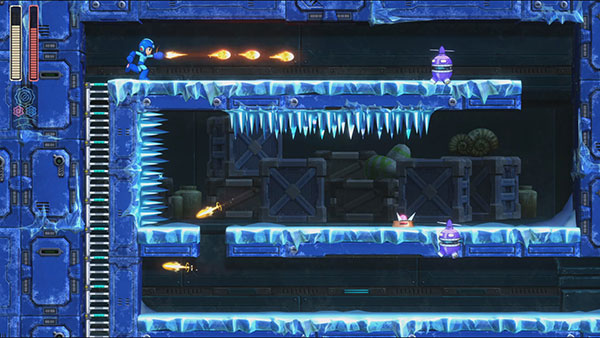
How is it as a sequel? Mega Man 10 is eight years old now — which means I’m like seventy billion years old — and I was real lukewarm on it. (Here are my thoughts on it from back when the game was new.) Mega Man 10 attempted to stir up the core formula by ramping up the boss fights. Whereas before you could generally just blast away with the proper weapon to kill any robot master, Mega Man 10 forces you to learn the fights whether you’re using the weakness or not. Some people liked this, I mostly didn’t, but it seems like Mega Man 9 ended up being the game from that era that everyone fondly remembers. The experiment was mostly worth trying, for people who love learning tough boss fights, but it broke something fundamental.
The first thing MM11 does is scutters the borked experiment, and tries something new. As well a sequel should. We’re back to absolutely demolishing robot masters if you come packing the proper equipment… for the most part. It’s not quite back to the MM6 days of walking in, pressing the fire button seven times, and clocking out. But it’s close.
The new thing is the Double Gear system. In addition to his charge shot and barrel full of robot master weapons, Mega Man has two new buttons: a Power Gear which charges up his weapons (in a different sense than his usual charge shot, I mean), and a Speed Gear which slows down time. He has a meter that fills while either gear is activated, and if you let it fill up entirely it overheats, shorting the system out and putting it offline for a little while. With some practice and good resource management, you’ll always have the gear you need when you need it.
The Power Gear works a bit like X’s buster upgrades in Mega Man X: fire a robot master weapon while your Power Gear is active, and you get a bigger, badder version of that weapon. This is a fun and flashy new toy, but it mostly has the same problem as X does: unequipped, it’s redundant with a system where you can already charge your shot anyway. And with a weapon, it generally just splits the weapon into more and less useful versions. Some weapons are better uncharged, some are better charged, and there aren’t a lot of interesting decision points here. In practice, the Power Gear mainly just adds two button presses to each shot; instead of equipping the Block Dropper and pressing fire, you press L2, then fire, then L2 again, so your Power Gear is active during the shot but isn’t running idle afterwards.
The Speed Gear is more interesting. Slowing or stopping time is not a new concept in Mega Man, but in the past it’s always been jankily tied to a weapon meter. At first it stopped time for as long as you had meter, meaning it was always empty when you were done with it; mostly only useful in the discrete stage areas it was designed for. Later they made each use shorter, but use less energy, but this didn’t work that well either, since a more universally-useful time weapon meant more enemies specifically made immune to it. In other iterations the time property was a charged effect on an otherwise normal weapon, but that mostly just turns it into the Purple Shot you use only on monsters weak to Purple.
The solution all along, it turns out, was twofold: it works because it is 1) divorced from a weapon meter, and 2) usable in conjunction with other weapons. It works best in short bursts, in situations where you need to pay close attention to precise positioning, or to squeeze in more shots of whatever weapon you’re using. It’s useful, it feels good to use, and it’s something which, six sequels from now, will make Mega Man 11 unique.
Everything up to and including the final boss is susceptible to the Speed Gear, but that’s not the praise it sounds like. A functionally-infinite time-slowing button has its cost, and the cost is the game designers saying, “Since we have this new Time Button, we can design some enemy attacks to be obnoxiously fast and impossible to dodge!” You’ll know which attacks these are, too, because the boss will flash blue just before they use them. This is consistent; a blue flash means “Speed Gear activated” for both Mega Man and his enemies (and a red one means “Power Gear activated”). My problem here is that the solution is always the same; use Speed Gear. You don’t get the fun of learning to interact with an interesting dodge pattern, because the attacks are too fast to dodge with human reflexes, and Speed Gear makes them too slow to be interesting.
So the Double Gear system mostly works, with only a few niggles. The important thing is, as a sequel, MM11 is moving the series forward without getting bogged down in 30 years of failed ideas. That’s mostly what I want from a series that only offers slight iterations on a core formula: I want new toys to play with, but I don’t want these toys to make the series unrecognizable.
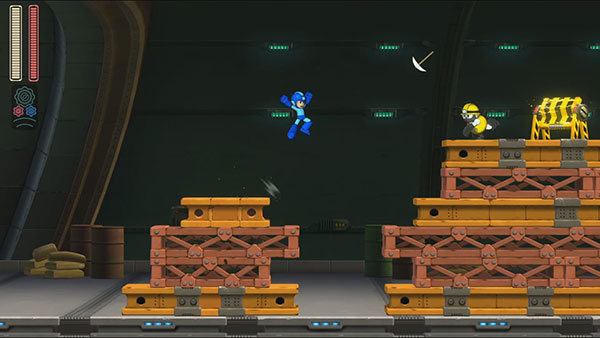
How is it as a classic Mega Man game? This series is so old and stupid that “classic” has two meanings. On one hand it means just the original Mega Man games, of which MM11 is the newest installment. But in another sense it means just the earliest of those games, before the experiments and cruft started to set in. Most people would consider the first five games to be “classic classic” Mega Man, and that’s how I’m using the term.
After those first five games, which were mostly largely the same, the series spent a long, long time scrabbling around trying to find somewhere solid to build. The greater Mega Man series is a weird and confusing place where, in the deepest darkest depths, you’re messing around with equipment, power-ups, upgrades to power-ups, and something called cyber-elves (??). It wasn’t pretty.
And it wasn’t really Capcom’s fault. The big criticism back in the 90s was that every Mega Man game was just the same; it’s no wonder they started mixing in power suits and treasure hunting and motorcycles and leveling systems and Duff McWhalen knows what else. Mega Man 9’s job, back in the day, was to go all the way back to the last installment that got unanimous praise — Mega Man 2 — and just make that again.
That’s similar to the situation MM11 found itself in. Capcom made the game people wanted, then a sequel to that game that people only sorta wanted, then eight years’ of radio silence. MM9 was a trick that was only going to work once, though; “return to form” doesn’t really make sense if the previous return was only two installments ago.
Instead of just being a no-frills classic Mega Man game, MM11 is an HD version of a no-frills classic Mega Man game. The levels are bright and beautiful and in glorious widescreen, but they’re built with simple tiles and blocks. The animations are crisp and fluid, but not over-drawn. Many of the stages have gimmicks, but the gimmicks always serve to accentuate the jump’n’shoot, rather than interrupt it.
In general, I wouldn’t be surprised to learn the design doc for MM11 started with, “First, design an NES game. Then, make it HD.” A de-make of this game would feel more or less at home in 1994, but the HD version we ended up with feels right in line with modern platformers like Shovel Knight or Bloodstained: Curse of the Moon.
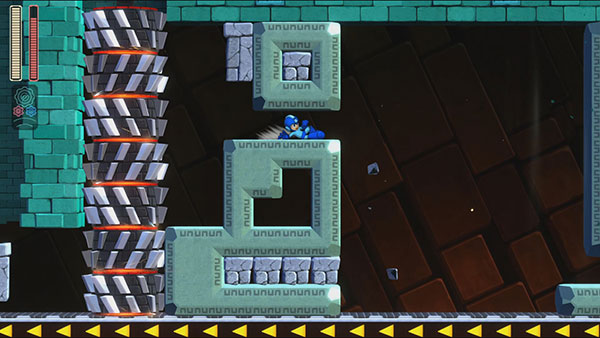
How is it as a modern Mega Man game? And yeah, because of the aformentioned “old and stupid” I’m using “modern” to mean everything from MM6 onward. Throughout those awkward middle installments, the primary focus of the series shifted from solid, predictable run’n’gun to blatant gimmickry. MM6 started the trend with its power suits. MM7 added intro and mid-way stages, and only gave you four robot masters at a time. The idea, it seems, was to give a bit more of a difficulty curve; you take on the back half of the stages with the guaranteed weapons from the front half. By MM8 most of the core gameplay elements were completely changed, and most of the stages had vehicle sections or puzzle elements or forced weapon sections.
This was around the time Capcom got away from the classic series and started focusing more on cyber-elves.
While Mega Man 11 takes most of its cues from earlier games, polished in simpler times, I did note that a lot of its stage elements seem to come from those troubled middle children. Tundra Man’s stage, an ice covered excavation site, could be MM7‘s Freeze Man’s second home. Blast Man’s exploding playground feels like a fun version of Grenade Man’s frustrating gauntlet. Acid Man’s rainbow-colored chemical vats, whose properties change as you allow monsters to barf their payload into them, is a better take on Burst Man’s laboratory. There’s a forest fire level, a bouncy spring maze… heck, even the Wily Machine fires missiles you can stand on. Quite a lot of the game feels like someone at Capcom looked at those middle games, the ones that aren’t as well-remembered, and asked to take another swing.
The most modern-feeling elements of Mega Man 11 are the quality of life additions. MM9 and MM10 very pointedly didn’t have any QOL improvements, in their quest to pretend to be NES titles. MM10 allowed shoulder button weapon switching, a sort of janky half-improvement scraped from the Mega Man X games. MM11 still has shoulder switching, if you want it, but the real improvement is the weapon wheel. Eight weapons, eight directions the right stick can point in… you’d really think this is a no-brainer that should have been in every title from the PlayStation onwards. Instead of trying to remember how many clicks away any weapon is, and in which direction, a number that changes with each new weapon you pick up… you just remember “down is my Impact Dash”.
I’ve played Mega Man X a hundred times over the years, and I still need the menu to switch weapons. By my second run of MM11 I was using the weapon wheel like a pro. This change, along with dedicated Rush Coil and Rush Jet buttons, really incentivizes switching weapons constantly in every stage. No amount of dinosaur-chasing or snowboarding or platform-steering can compare, when it comes to actually feeling like Mega Man.
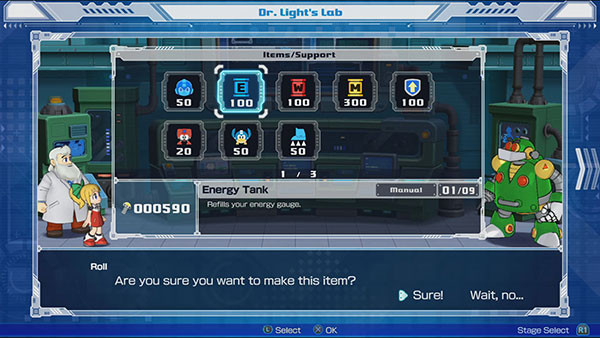
Finally, (finally!) there’s a kind of silly and awkward angle with which you could look at Mega Man 11: how is it when compared with Mighty No. 9?
This is an unfair question, but it’s unfair in an enlightening way. I didn’t back MN9, and I haven’t played it. I’ve seen streamers play the game to completion, and I followed the whole glorious shitshow of its development cycle, though. Story goes, during the years when Capcom was letting Mega Man lay fallow, some cheeky developers thought they’d step in make a game that was Mega Man in all but name. It got funded instantly by two generations of Mega Man fans, and then the finished product turned out to be a low-quality, cheap-feeling game with stapled-on gameplay systems that didn’t feel much like Mega Man at all.
Some people paid extra for boxes and instruction manuals, and the manuals didn’t fit inside the boxes. And something something pizza explosions on prom night. What a mess.
Why is any of this important? Because as bad as Mighty No. 9 was, I honestly don’t think we’d have gotten Mega Man 11 without it. Or, at least, we wouldn’t have gotten it in this state. If anything could be objectively mined from the spectacular failure of MN9, it’s that there were still enough fans out there craving the Mega Man experience. We’re experiencing something of a 2d platformer rennaisance at the moment, and someone at Capcom was going to want to get on this train eventually, but without MN9 as a pretty clear benchmark for “don’t do it like that”, I think MM11 might have ended up somewhere more along the lines of MM8: a pretty but bloated game, with cobbled-together design elements and voice acting you couldn’t turn off.
MN9 was supposed to be a snub at Capcom who, it was alleged, didn’t know how to make a Mega Man game anymore. Instead, it served as a bright and clear reminder of how the series got off the rails in the first place. In a roundabout way, all those Kickstarter backers eventually got what they asked for after all.
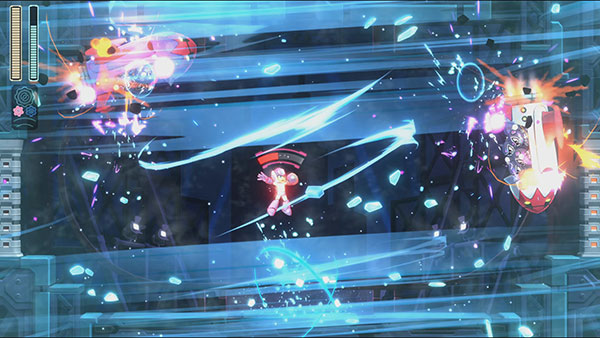
I don’t know where the series goes from here. I think Capcom could enjoy a second “NES era”, just using MM11‘s game engine to make a new sequel with eight new dudes every couple of years, for as long as people continue to enjoy platformers. Or maybe that way lies madness, and the cyber-elves would creep back in and poop all over everything. Or maybe this was a one-off fluke; now that MN9 has been shown up, the blue bomber is just going back in the closet for another eight or nine years.
But Mega Man 11 is pretty excellent. I’m glad to be playing it. Thank you for reading all these words I wrote about it!
Leave a Reply